Peugeot 207 CC 2014 Owners Manual
Manufacturer: PEUGEOT, Model Year: 2014, Model line: 207 CC, Model: Peugeot 207 CC 2014Pages: 232, PDF Size: 11.11 MB
Page 91 of 232
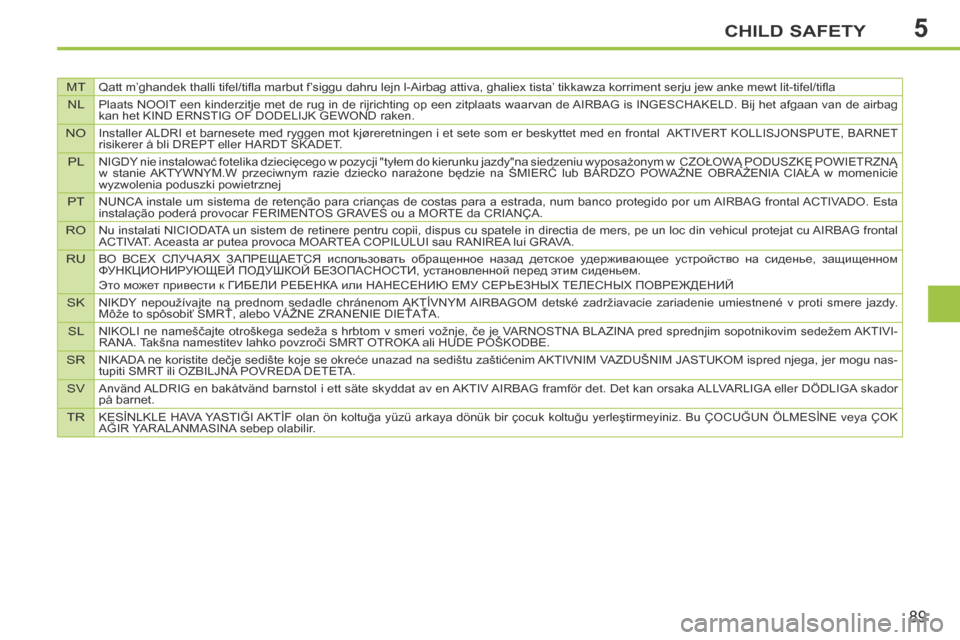
5
MTQatt m’ghandek thalli tifel/tifl a marbut f’siggu dahru lejn l-Airbag attiva, ghaliex tista’ tikkawza korriment serju jew anke mewt lit-tifel/tifl a
NLPlaats NOOIT een kinderzitje met de rug in de rijrichting op een zitplaats waarvan d\
e AIRBAG is INGESCHAKELD. Bij het afgaan van de airbag
kan het KIND ERNSTIG OF DODELIJK GEWOND raken.
NOInstaller ALDRI et barnesete med ryggen mot kjøreretningen i et sete som er beskyttet med en frontal AKTIVERT KOLLISJONSPUTE, BARNET
risikerer å bli DREPT eller HARDT SKADET.
PLNIGDY nie instalować fotelika dziecięcego w pozycji "tyłem do kierunku jazdy"na siedzeniu wyposażonym w CZOŁOWĄ PODUSZKĘ POWIETRZNĄ
w stanie AKTYWNYM.W przeciwnym razie dziecko narażone będzie na ŚMIERĆ lub BARDZO POWAŻNE OBRAŻENIA CIAŁA w momenicie
wyzwolenia poduszki powietrznej
PTNUNCA instale um sistema de retenção para crianças de costas para a estrada, num banco protegido por um AIRBAG frontal ACTIVADO. Esta
instalação poderá provocar FERIMENTOS GRAVES ou a MORTE da CRIANÇA.
RONu instalati NICIODATA un sistem de retinere pentru copii, dispus cu spatele in directia de me\
rs, pe un loc din vehicul protejat cu AIRBAG frontal
ACTIVAT. Aceasta ar putea provoca MOARTEA COPILULUI sau RANIREA lui GRAVA.
RUВО ВСЕХ СЛУЧАЯХ ЗАПРЕЩАЕТСЯ использовать обращенное назад детское удерживающее устройство на сиденье, защищенном
ФУНКЦИОНИРУЮЩЕЙ ПОДУШКОЙ БЕЗОПАСНОСТИ, установленной перед этим сиденьем.
Это может привести к ГИБЕЛИ РЕБЕНКА или НАНЕСЕНИЮ ЕМУ СЕРЬЕЗНЫХ ТЕЛЕСНЫХ ПОВРЕЖДЕНИЙ
SKNIKDY nepoužívajte na prednom sedadle chránenom AKTÍVNYM AIRBAGOM detské zadržiavacie zariadenie umiestnené v proti smere jazdy.
Môže to spôsobiť SMRŤ, alebo VÁŽNE ZRANENIE DIEŤAŤA.
SLNIKOLI ne nameščajte otroškega sedeža s hrbtom v smeri vožnje, če je VARNOSTNA BLAZINA pred sprednjim sopotnikovim sedežem AKTIVI-
RANA. Takšna namestitev lahko povzroči SMRT OTROKA ali HUDE POŠKODBE.
SRNIKADA ne koristite dečje sedište koje se okreće unazad na sedištu zaštićenim AKTIVNIM VAZDUŠNIM JASTUKOM ispred njega, jer mogu nas-
tupiti SMRT ili OZBILJNA POVREDA DETETA.
SVAnvänd ALDRIG en bakåtvänd barnstol i ett säte skyddat av en AKTIV AIRBAG framför det. Det kan orsaka ALLVARLIGA eller DÖDLIGA skador
på barnet.
TRKESİNLKLE HAVA YASTIĞI AKTİF olan ön koltuğa yüzü arkaya dönük bir çocuk koltuğu yerleştirmeyiniz. Bu ÇOCUĞUN ÖLMESİNE veya ÇOK
AĞIR YARALANMASINA sebep olabilir.
CHILD SAFETY
89
207CC_EN_CHAP05_SECURITE ENFANTS_ED01-2014
Page 92 of 232
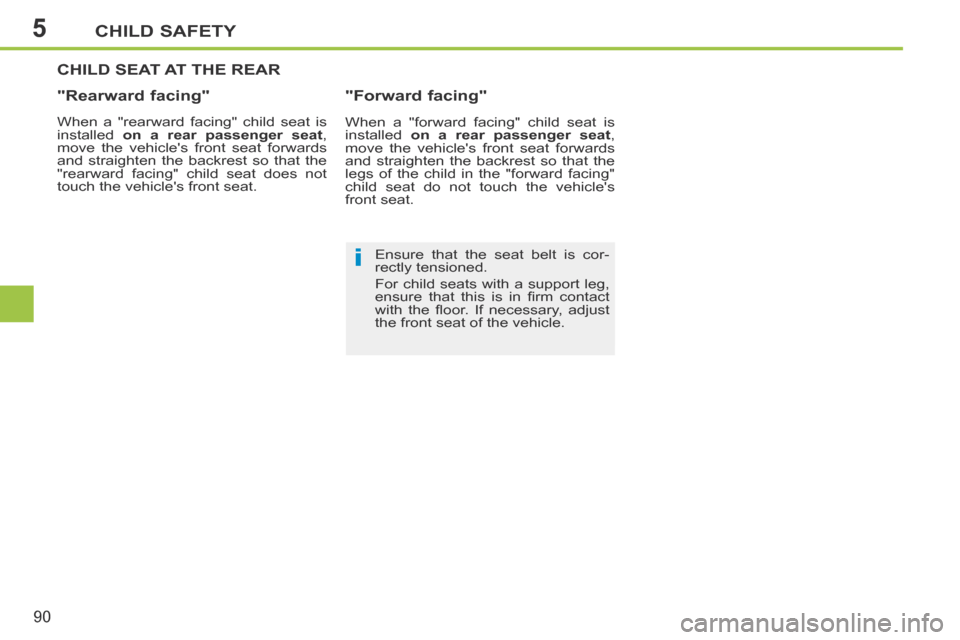
5
i
CHILD SAFETY
90
207CC_EN_CHAP05_SECURITE ENFANTS_ED01-2014
CHILD SEAT AT THE REAR
"Rearward facing"
When a "rearward facing" child seat is
installed on a rear passenger seat ,
move the vehicle's front seat forwards
and straighten the backrest so that the
"rearward facing" child seat does not
touch the vehicle's front seat.
"Forward facing"
When a "forward facing" child seat is
installed on a rear passenger seat ,
move the vehicle's front seat forwards
and straighten the backrest so that the
legs of the child in the "forward facing"
child seat do not touch the vehicle's
front seat.
Ensure that the seat belt is cor-
rectly tensioned.
For child seats with a support leg,
ensure that this is in fi rm contact
with the fl oor. If necessary, adjust
the front seat of the vehicle.
Page 93 of 232
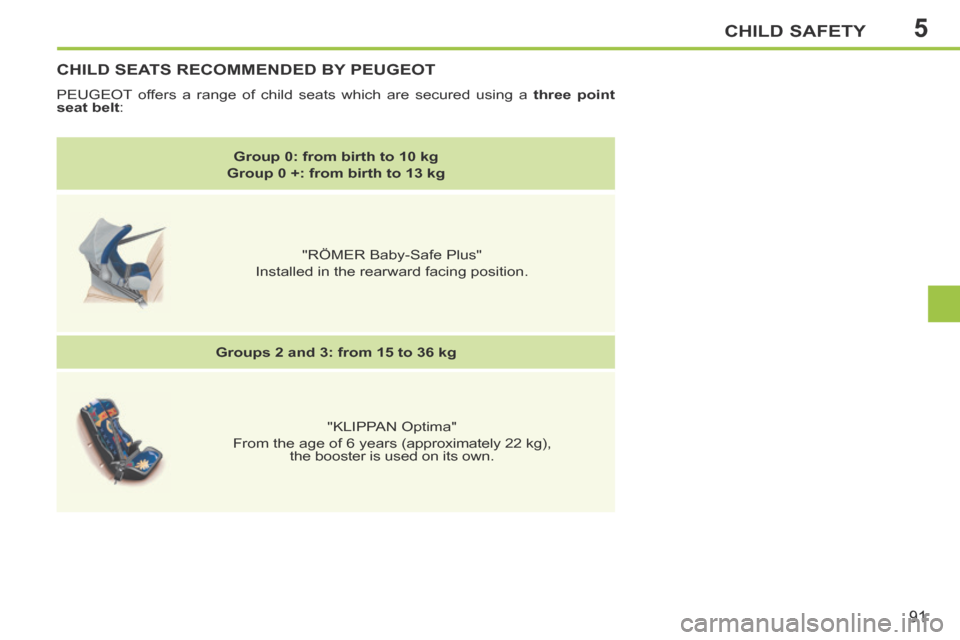
5CHILD SAFETY
91
207CC_EN_CHAP05_SECURITE ENFANTS_ED01-2014
CHILD SEATS RECOMMENDED BY PEUGEOT
PEUGEOT offers a range of child seats which are secured using a three point
seat belt :
Group 0: from birth to 10 kg
Group 0 +: from birth to 13 kg
"RÖMER Baby-Safe Plus"
Installed in the rearward facing position.
Groups 2 and 3: from 15 to 36 kg "KLIPPAN Optima"
From the age of 6 years (approximately 22 kg), the booster is used on its own.
Page 94 of 232

5
i
CHILD SAFETY
92
207CC_EN_CHAP05_SECURITE ENFANTS_ED01-2014
LOCATIONS FOR CHILD SEATS SECURED WITH A SEAT BELT
In accordance with European regulations, this table indicates the option\
s for the installation of child seats secured using the
seat belt and universally approved (a) in relation to the weight of th\
e child and the seat in the vehicle.
(a) Universal child seat: child seat which can be installed in all vehicles using the seat belt.
(b) Group 0: from birth to 10 kg. Infant car seats and "car cots" cannot be \
installed on the front passenger seat.
(c) Consult the legislation in force in your country before installing your child on this seat.
(d) To install a child seat, move the front seat forward, then put the seat b\
ack in the upright position to leave enough space for the child seat and the child'\
s legs.
The front seat can be moved further forward than the intermediate longit\
udinal
position.
U : seat suitable for the installation of a child seat secured using the sea\
t belt and universally approved "rearward facing" and/or "forward facing".
U(R) : identical to U , with the vehicle's seat adjusted to its highest position.
Seat
Weight of the child /indicative age
Less than 13 kg
(groups 0 (b) and 0+) Up to 1 year approx From 9 to 18 kg
(group 1)
From 1 to 3 years approx From 15 to 25 kg
(group 2)
From 3 to 6 years approx From 22 to 36 kg
(group 3)
From 6 to 10 years approx
Front passenger seat (c)
- fi x e d
U U U U
- height adjustable
U(R) U(R) U(R) U(R)
Outer rear
seats (d)
U U U U
Remove and stow the head re-
straint before installing a child
seat with a backrest on a passen-
ger seat. Refi t the head restraint
once the child seat has been re-
moved.
Page 95 of 232
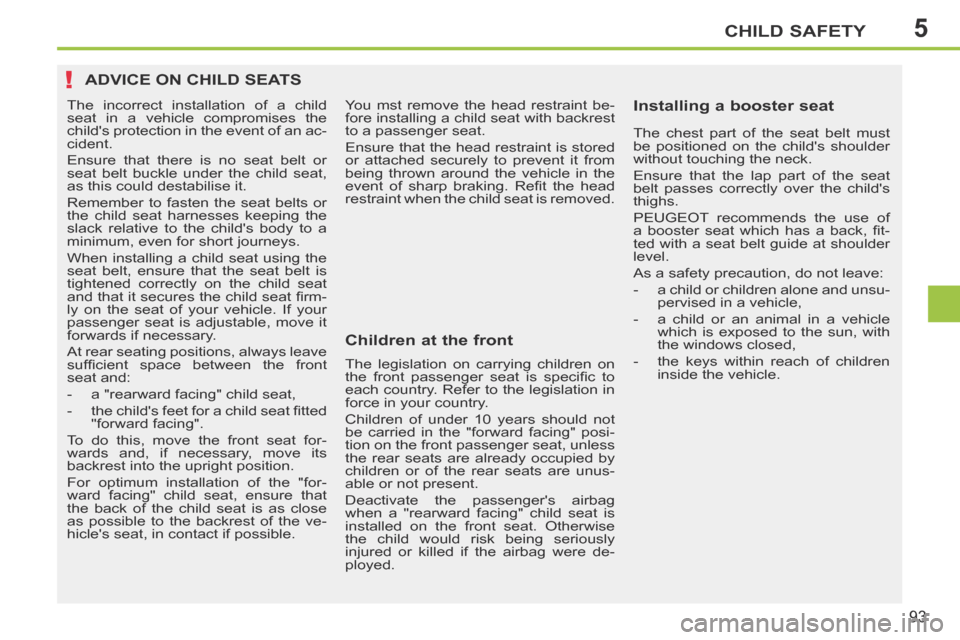
5
!
CHILD SAFETY
93
207CC_EN_CHAP05_SECURITE ENFANTS_ED01-2014
ADVICE ON CHILD SEATS
Children at the front Installing a booster seat
You mst remove the head restraint be-
fore installing a child seat with backrest
to a passenger seat.
Ensure that the head restraint is stored
or attached securely to prevent it from
being thrown around the vehicle in the
event of sharp braking. Refi t the head
restraint when the child seat is removed.
The incorrect installation of a child
seat in a vehicle compromises the
child's protection in the event of an ac-
cident.
Ensure that there is no seat belt or
seat belt buckle under the child seat,
as this could destabilise it.
Remember to fasten the seat belts or
the child seat harnesses keeping the
slack relative to the child's body to a
minimum, even for short journeys.
When installing a child seat using the
seat belt, ensure that the seat belt is
tightened correctly on the child seat
and that it secures the child seat fi rm-
ly on the seat of your vehicle. If your
passenger seat is adjustable, move it
forwards if necessary.
At rear seating positions, always leave
suffi cient space between the front
seat and:
- a "rearward facing" child seat,
- the child's feet for a child seat fi tted
"forward facing".
To do this, move the front seat for-
wards and, if necessary, move its
backrest into the upright position.
For optimum installation of the "for-
ward facing" child seat, ensure that
the back of the child seat is as close
as possible to the backrest of the ve-
hicle's seat, in contact if possible. The legislation on carrying children on
the front passenger seat is specifi c to
each country. Refer to the legislation in
force in your country.
Children of under 10 years should not
be carried in the "forward facing" posi-
tion on the front passenger seat, unless
the rear seats are already occupied by
children or of the rear seats are unus-
able or not present.
Deactivate the passenger's airbag
when a "rearward facing" child seat is
installed on the front seat. Otherwise
the child would risk being seriously
injured or killed if the airbag were de-
ployed. The chest part of the seat belt must
be positioned on the child's shoulder
without touching the neck.
Ensure that the lap part of the seat
belt passes correctly over the child's
thighs.
PEUGEOT recommends the use of
a booster seat which has a back, fi t-
ted with a seat belt guide at shoulder
level.
As a safety precaution, do not leave:
- a child or children alone and unsu-
pervised in a vehicle,
- a child or an animal in a vehicle which is exposed to the sun, with
the windows closed,
- the keys within reach of children inside the vehicle.
Page 96 of 232
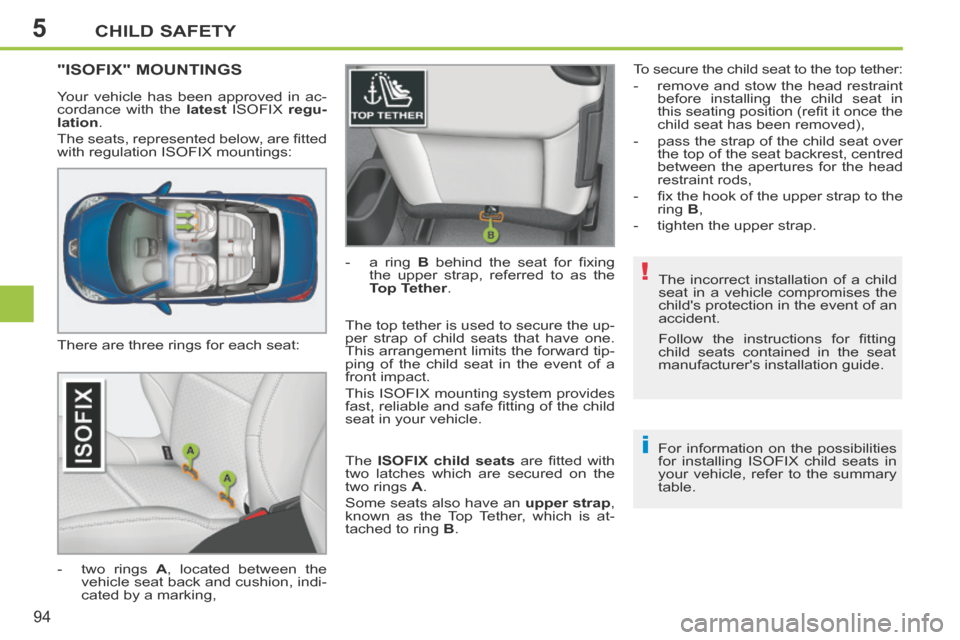
5
!
i
CHILD SAFETY
94
207CC_EN_CHAP05_SECURITE ENFANTS_ED01-2014
The incorrect installation of a child
seat in a vehicle compromises the
child's protection in the event of an
accident.
For information on the possibilities
for installing ISOFIX child seats in
your vehicle, refer to the summary
table.
"ISOFIX" MOUNTINGS
There are three rings for each seat:
- two rings A , located between the vehicle seat back and cushion, indi-
cated by a marking, - a ring B behind the seat for fi xing
the upper strap, referred to as the
Top Tether .
The top tether is used to secure the up-
per strap of child seats that have one.
This arrangement limits the forward tip-
ping of the child seat in the event of a
front impact.
This ISOFIX mounting system provides
fast, reliable and safe fi tting of the child
seat in your vehicle.
Your vehicle has been approved in ac-
cordance with the
latest ISOFIX regu-
lation .
The seats, represented below, are fi tted
with regulation ISOFIX mountings:
The ISOFIX child seats are fi tted with
two latches which are secured on the
two rings A .
Some seats also have an upper strap ,
known as the Top Tether, which is at-
tached to ring B . To secure the child seat to the top tether:
- remove and stow the head restraint
before installing the child seat in
this seating position (refi t it once the
child seat has been removed),
- pass the strap of the child seat over the top of the seat backrest, centred
between the apertures for the head
restraint rods,
- fi x the hook of the upper strap to the ring B ,
- tighten the upper strap.
Follow the instructions for fi tting
child seats contained in the seat
manufacturer's installation guide.
Page 97 of 232
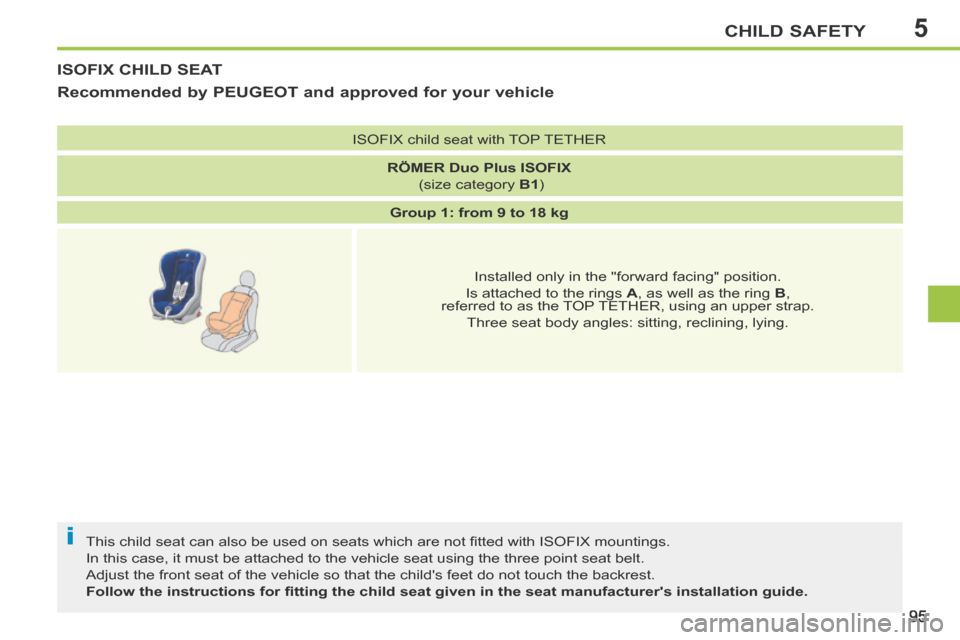
5
i
CHILD SAFETY
95
207CC_EN_CHAP05_SECURITE ENFANTS_ED01-2014
ISOFIX CHILD SEAT
This child seat can also be used on seats which are not fi tted with ISOFIX mountings.
In this case, it must be attached to the vehicle seat using the three po\
int seat belt.
Adjust the front seat of the vehicle so that the child's feet do not tou\
ch the backrest.
Follow the instructions for fi tting the child seat given in the seat manufacturer's installation guide.
Recommended by PEUGEOT and approved for your vehicle
ISOFIX child seat with TOP TETHER RÖMER Duo Plus ISOFIX (size category B1 )
Group 1: from 9 to 18 kg
Installed only in the "forward facing" position.
Is attached to the rings A , as well as the ring B ,
referred to as the TOP TETHER, using an upper strap.
Three seat body angles: sitting, reclining, lying.
Page 98 of 232
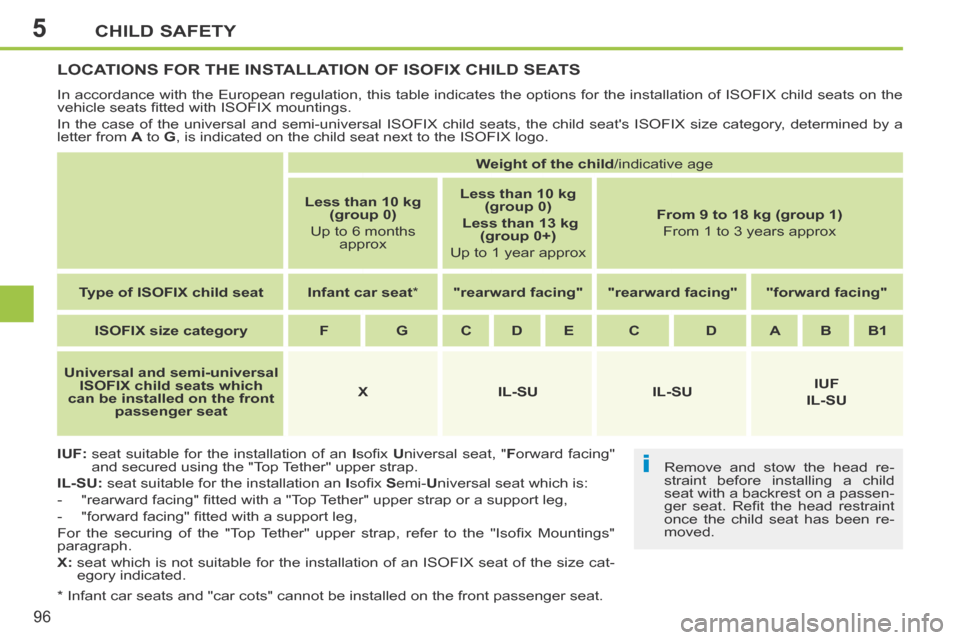
5
i
CHILD SAFETY
96
207CC_EN_CHAP05_SECURITE ENFANTS_ED01-2014
LOCATIONS FOR THE INSTALLATION OF ISOFIX CHILD SEATS
In accordance with the European regulation, this table indicates the opt\
ions for the installation of ISOFIX child seats on the
vehicle seats fi tted with ISOFIX mountings.
In the case of the universal and semi-universal ISOFIX child seats, the \
child seat's ISOFIX size category, determined by a
letter from A to G , is indicated on the child seat next to the ISOFIX logo.
IUF: seat suitable for the installation of an I sofi x U niversal seat, " F orward facing"
and secured using the "Top Tether" upper strap.
IL-SU: seat suitable for the installation an I sofi x S emi- U niversal seat which is:
- "rearward facing" fi tted with a "Top Tether" upper strap or a support leg,
- "forward facing" fi tted with a support leg,
For the securing of the "Top Tether" upper strap, refer to the "Isofi x Mountings"
paragraph.
X: seat which is not suitable for the installation of an ISOFIX seat of the size cat- egory indicated.
Weight of the child/ indicative age
Less than 10 kg (group 0)
Up to 6 months approx Less than 10 kg
(group 0)
Less than 13 kg
(group 0+)
Up to 1 year approx From 9 to 18 kg (group 1)
From 1 to 3 years approx
Type of ISOFIX child seat Infant car seat * " rearward facing" " rearward facing" "forward facing"
ISOFIX size category F G C D E C D A B B1
Universal and semi-universal ISOFIX child seats which
can be installed on the front passenger seat X
IL-SU IL-SU IUF
IL-SU
* Infant car seats and "car cots" cannot be installed on the front passeng\
er seat. Remove and stow the head re-
straint before installing a child
seat with a backrest on a passen-
ger seat. Refi t the head restraint
once the child seat has been re-
moved.
Page 99 of 232
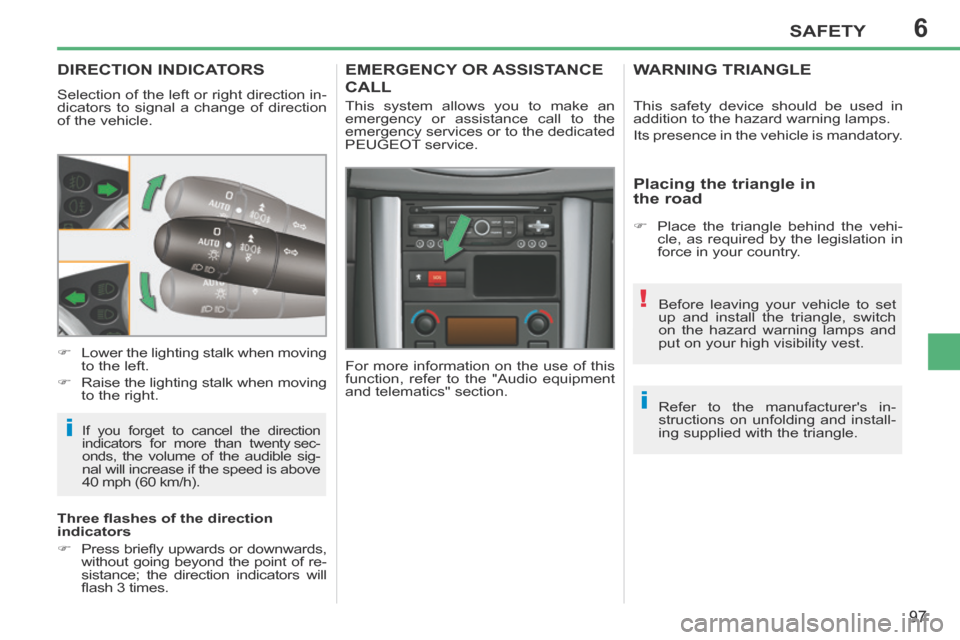
6
i
i
!
SAFETY
97
207CC_EN_CHAP06_SECURITE_ED01-2014
DIRECTION INDICATORS
Selection of the left or right direction in-
dicators to signal a change of direction
of the vehicle.
If you forget to cancel the direction
indicators for more than twenty sec-
onds
, the volume of the audible sig-
nal will increase if the speed is above
40 mph (60 km/h).
Lower the lighting stalk when moving
to the left.
Raise the lighting stalk when moving to the right.
Three fl ashes of the direction
indicators
Press briefl y upwards or downwards, without going beyond the point of re-
sistance; the direction indicators will
fl ash 3 times.
EMERGENCY OR ASSISTANCE
CALL
For more information on the use of this
function, refer to the "Audio equipment
and telematics" section. This system allows you to make an
emergency or assistance call to the
emergency services or to the dedicated
PEUGEOT service. This safety device should be used in
addition to the hazard warning lamps.
Its presence in the vehicle is mandatory.
WARNING TRIANGLE
Placing the triangle in
the road
Place the triangle behind the vehi-
cle, as required by the legislation in
force in your country.
Before leaving your vehicle to set
up and install the triangle, switch
on the hazard warning lamps and
put on your high visibility vest.
Refer to the manufacturer's in-
structions on unfolding and install-
ing supplied with the triangle.
Page 100 of 232
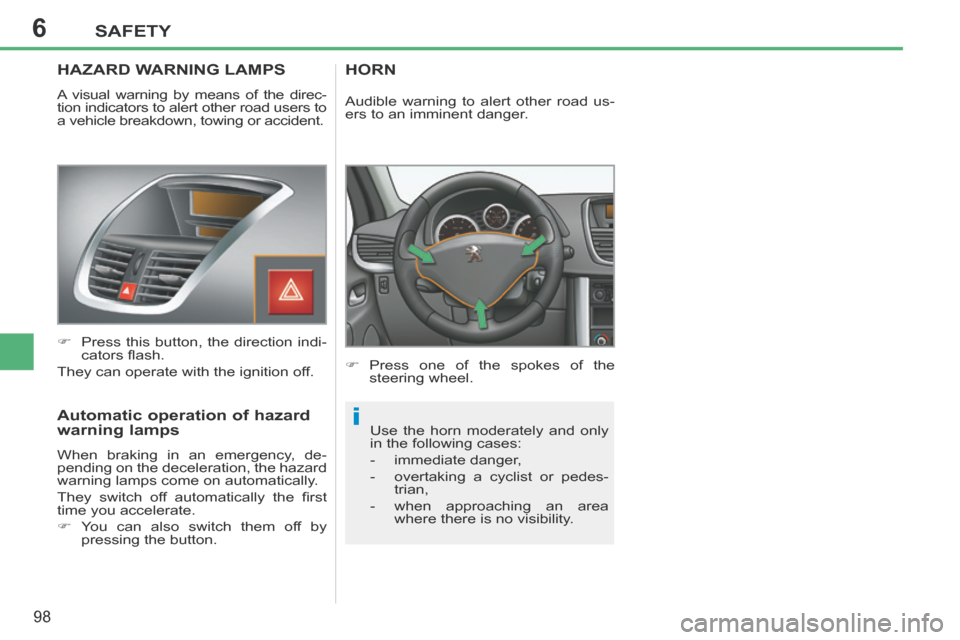
6
i
SAFETY
98
207CC_EN_CHAP06_SECURITE_ED01-2014
HAZARD WARNING LAMPS
A visual warning by means of the direc-
tion indicators to alert other road users to
a vehicle breakdown, towing or accident.
Press this button, the direction indi-cators fl ash.
They can operate with the ignition off.
Automatic operation of hazard
warning lamps
When braking in an emergency, de-
pending on the deceleration, the hazard
warning lamps come on automatically.
They switch off automatically the fi rst
time you accelerate.
You can also switch them off by pressing the button.
HORN
Press one of the spokes of the steering wheel.
Use the horn moderately and only
in the following cases:
- immediate danger,
- overtaking a cyclist or pedes- trian,
- when approaching an area where there is no visibility.
Audible warning to alert other road us-
ers to an imminent danger.